Vesicular transport and salt tolerance (Viewpoint)

Annals of Botany 123: 1–18, 2019
doi: 10.1093/aob/mcy164
At the extreme of salt tolerance shown by plants is a small group of about 1500 halophytes. Most of these plants can accumulate shoot sodium concentrations of around 500 mM: some excrete salt through specialised glands. Flowers et al. collect data on the rates of sodium transport found in halophytes and outline vesicle transport systems in general. There is good evidence of vesicular transport in plants and sodium fluxes are compatible with rates of vesicle turnover. Flowers et al. conclude it is timely to re-evaluate the role of vesicles in ion transport and the genes that might be selected to generate salt-tolerant crops.
Authors: Timothy J. Flowers, Edward P. Glenn, and Vadim Volkov
East African traditional bananas: the resources of an understated diversity (Research in Context)
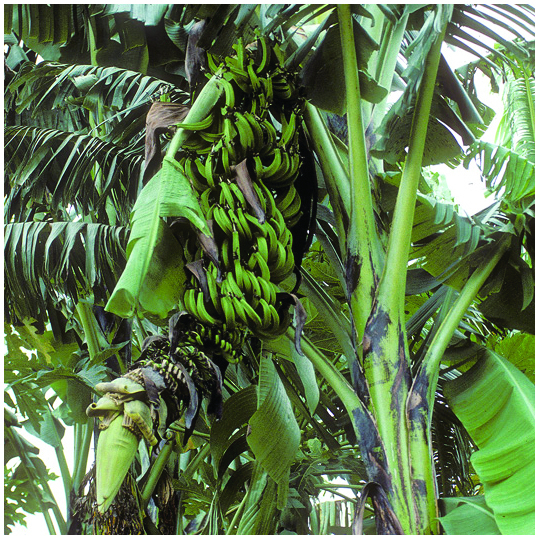
Annals of Botany 123: 19–36, 2019
doi: 10.1093/aob/mcy156
Banana cultivation is a long tradition for numerous communities in East Africa, growing particularly the robust diploid ‘Mchare’ variety in the Kilimanjaro and the triploid ‘Mutika’ in the Great Lakes region. Since the 1970s, drastic yield declines due to soil degradation and emergent pests and diseases, has led to the disaffection by farmers for traditional varieties. Improved varieties are needed requiring elucidating the genetic origins of these unique bananas. Perrier et al. show that ‘Mchare’, ‘Mutika’ and other related East African diploids and triploids are connected within the same genetic complex whose primary centre is in Southeast Asia. They also report the likely migration routes into Africa. Identification of the appropriate parents for breeding programs will boost the genetic improvement of East African bananas, but also of other globally important subgroups.
Authors: Xavier Perrier, Christophe Jenny, Frédéric Bakry, Deborah Karamura, Mercy Kitavi, Cécile Dubois, Catherine Hervouet, Gérard Philippson, and Edmond De Langhe
Cytosolic dehydrogenase in Arabidopsis responses to root-knot nematode infection
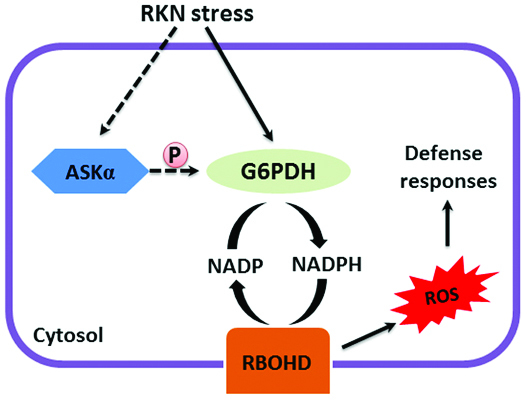
Annals of Botany 123: 37–46, 2019
doi: 10.1093/aob/mcy124
Plant defence reaction is associated with activation of primary metabolic pathways. Glucose-6-phosphate dehydrogenase (G6PDH), the key enzyme of the oxidative pentose phosphate (OPP), pathway is involved in plant responses to abiotic stresses and pathogenesis. Hu et al. assess the role of G6PDH in regulating plant defence response during plant-nematode interaction. Root-knot nematode infection caused a rapid increase in G6PDH activity and protein abundance. Arabidopsis double mutant g6pd5/6 showed enhanced susceptibility, reduced ROS production, and partly suppressing the basal defence gene expression. Hu et al. propose a new aspect of G6PDH-mediated OPP pathway in plant basal defence against root-knot nematodes.
Authors: Yanfeng Hu, Jia You, Jisheng Li, and Congli Wang
Arabinogalactan proteins (AGPs) and pectins in apple fruits during postharvest storage
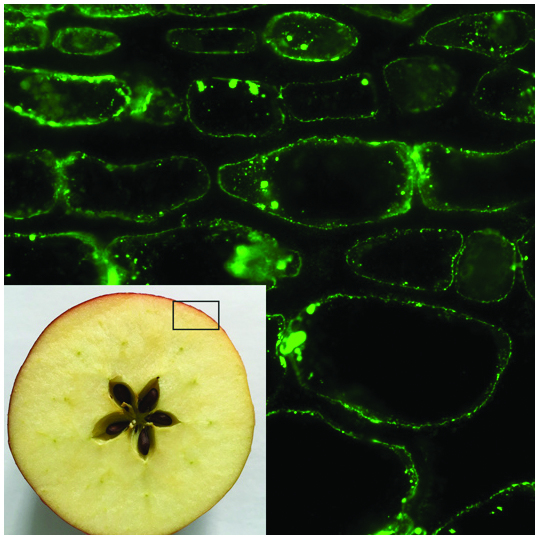
Annals of Botany 123: 47–55, 2019
doi: 10.1093/aob/mcy133
Changes in the arrangement of cell wall components determine cell wall properties (integrity, stiffness), thereby affecting the macro properties of fruits, which are important for consumers and industry. The immunocytochemical study was conducted to elucidate the distribution of arabinogalactan proteins (AGPs) and pectic polysaccharides contained in apple (Malus x domestica) fruits during senescence process. Microscopy observations showed spatio-temporal changes in the localization and dependencies between all examined constituents. Leszczuk et al. propose that AGPs are involved in establishment of the cell wall – plasma membrane continuum.
Authors: Agata Leszczuk, Monika Chylińska, and Artur Zdunek
The pathways of absorption of foliar-applied Zn in sunflower
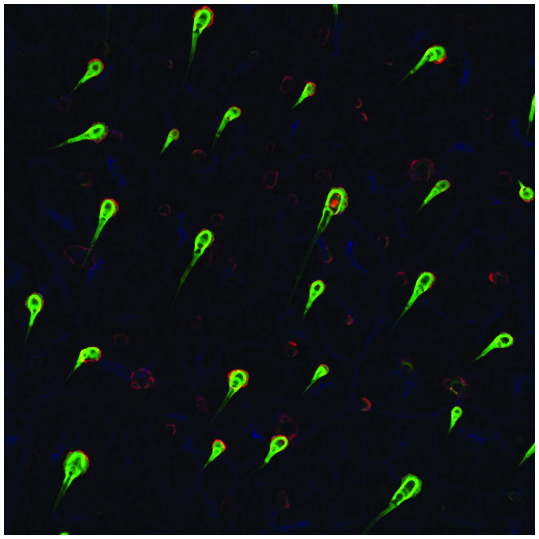
Annals of Botany 123: 57–68, 2019
doi: 10.1093/aob/mcy135
Despite foliar fertilisation being increasingly used, the pathway by which the nutrients move across the leaf surface remains unclear. Using innovative approaches, including synchrotron-based techniques and NanoSIMS, Li et al. find in sunflower (Helianthus annuus, Asteraceae) that the trichomes and cuticle rather than stomata seem to play important roles for foliar Zn absorption. The bundle sheath extensions that connect with the non-glandular trichomes, are most likely responsible for the subsequent movement of the absorbed Zn. It is also found that the foliar applied nano-ZnO was absorbed as Zn ions rather than nanoparticles.
Authors: Cui Li, Peng Wang, Antony van der Ent, Miaomiao Cheng, Haibo Jiang, Thea Lund Read, Enzo Lombi, Caixian Tang, Martin de Jonge, Neal W. Menzies, and Peter M. Kopittke
Divergent evolution of the chalcone synthase gene family in Phalaenopsis orchids
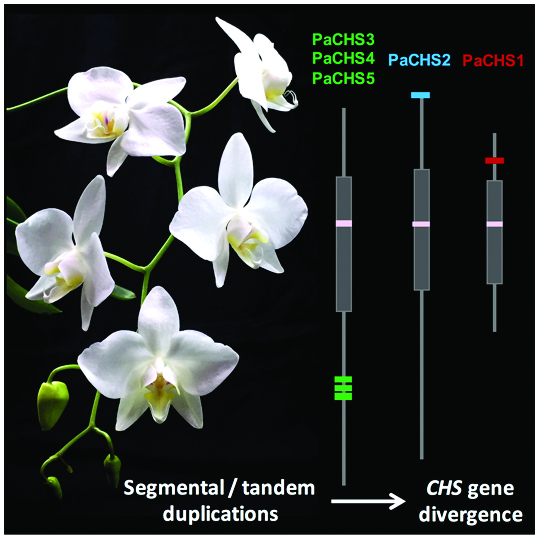
Annals of Botany 123: 69–77, 2019
doi: 10.1093/aob/mcy136
The evolutionary success of orchid family is driven by its extraordinary adaptation. Chalcone synthase (CHS) gene encodes the key enzyme for biosynthesis of flavonoids, secondary metabolites important for plant adaptation. Kuo et al. report the first chromosome-scale study of CHS genes in Phalaenopsis orchids. Five paralogous CHS genes identified from Ph. aphrodite transcriptomic datasets were classified into three groups that were localised on three distinct chromosomes by high-resolution FISH mapping. Their sequence divergences and expression profiles are highly correlated with their chromosomal distributions. Kuo et al. propose that the expansion of the CHS gene family occurred through segmental duplications, followed by tandem duplications.
Authors: Yi-Tzu Kuo, Ya-Ting Chao, Wan-Chieh Chen, Ming-Che Shih, and Song-Bin Chang
OsDCL1 activation compromises resistance against rice blast fungus
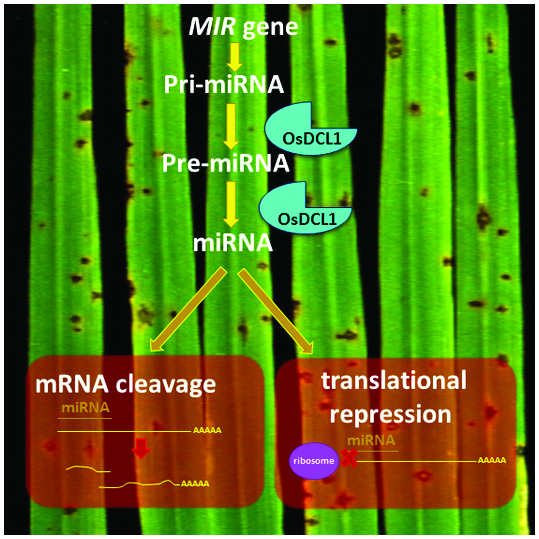
Annals of Botany 123: 79–93, 2019
doi: 10.1093/aob/mcy141
Rice blast, caused by the pathogen Magnaporthe oryzae, is the most important fungal disease of cultivated rice (Oryza sativa). Salvador-Guirao et al. investigate the contribution of DCL1, the core component for microRNA (miRNA) biogenesis in rice immunity. OsDCL1a activation enhances susceptibility to M. oryzae. Main features of dcl1a-activation in rice plants include the misregulation of genes involved in detoxification of reactive oxygen species, inability to produce diterpenoid phytoalexins during M. oryzae infection, and alterations in the rice miRNAome. A better understanding of DCL1 function provides the basis for developing novel strategies to improve blast resistance in rice.
Authors: Raquel Salvador-Guirao, Patricia Baldrich, Shiho Tomiyama, Yue-Ie Hsing, Kazunori Okada, and Blanca San Segundo
Morpho-physiological dormancy described in seeds of waterlilies (Nymphaea)
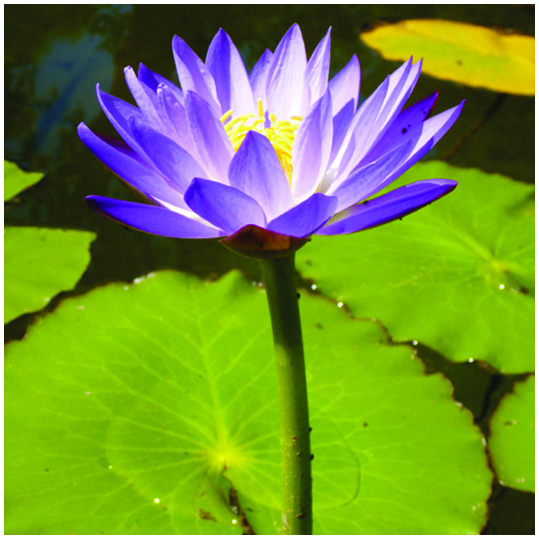
Annals of Botany 123: 95–106, 2019
doi: 10.1093/aob/mcy142
Substantial evidence supports morpho-physiological dormancy (MPD) as the basal kind of seed dormancy in flowering plants. However, for seeds of waterlilies (Nymphaea, Nymphaeaceae), only physiological dormancy (PD) is reported. Dalziell et al. determine seed dormancy and germination traits for six tropical Australian species of Nymphaea. Mature seeds of all species were dormant. Embryos in N. macrosperma, N. ondinea and N. violacea seeds lengthened prior to germination, and seeds of these species have MPD. Seeds of the other species possess PD. Results show seeds in the most phylogenetically derived clades within Nymphaea have MPD, suggesting PD is likely the basal trait within the Nymphaeales.
Authors: Emma L. Dalziell, Carol C. Baskin, Jerry M. Baskin, Rennee E. Young, Kingsley W. Dixon, and David J. Merritt
Intraspecific variation in soy across the leaf economics spectrum
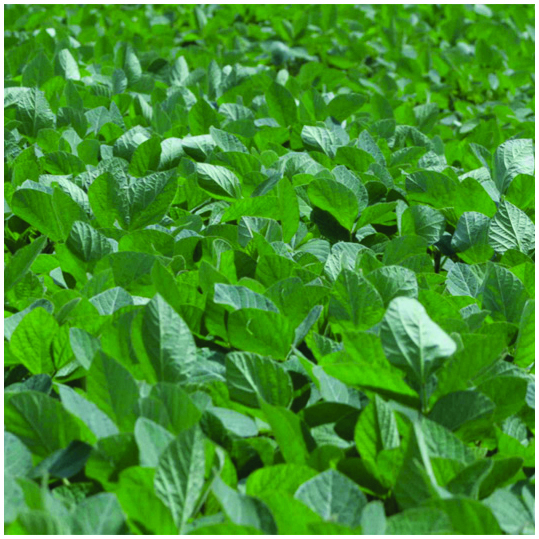
Annals of Botany 123: 107–120, 2019
doi: 10.1093/aob/mcy147
Leaf economics traits are central in understanding and predicting the effects of plant biodiversity on ecosystem functioning. Using soybean (Glycine max) – one of the world’s most widespread crops, Hayes et al. show that leaf economics traits also differ widely among crops of the same genotype. Differences in soy leaf traits among plants can be predicted by managed environmental conditions and observed changes through plant development. The study by Hayes et al. shows that a small number of leaf traits are able to closely predict soy yield.
Authors: Fallon J. Hayes, Serra W. Buchanan, Brent Coleman, Andrew M. Gordon, Peter B. Reich, Naresh V. Thevathasan, Ian J. Wright, and Adam R. Martin
Salinity decreases cadmium translocation in the halophyte Carpobrotus rossii
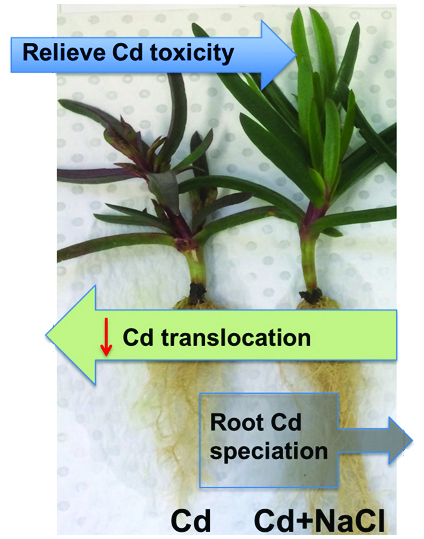
Annals of Botany 123: 121–132, 2019
doi: 10.1093/aob/mcy148
Salt has been shown to affect cadmium (Cd) translocation and accumulation in plants, but the associated mechanisms are unclear. Cheng et al. report a hydroponic experiment to examine the effects of salt type and concentration on Cd uptake, translocation and accumulation in the halophyte Carpobrotus rossii, Aizoaceae. The accumulation of peptides and organic acids were measured, and Cd in plant tissues was analysed using synchrotron-based X-ray absorption spectroscopy. Cheng et al. find that added salt decreased shoot Cd accumulation by decreasing Cd root-to-shoot translocation due to the rapid formation of low mobility Cd-S complexes without changing the concentrations of glutathione and phytochelatins.
Authors: Miaomiao Cheng, Peter M. Kopittke, Anan Wang, and Caixian Tang
Evolutionary implications of seed-cone teratologies in Pseudotaxus chienii
Annals of Botany 123: 133–143, 2019
doi: 10.1093/aob/mcy150
The ovule-bearing organs of the yew family Taxaceae differ from typical conifer seed-cones in possessing a fleshy structure surrounding the ovule/seed, which is variously interpreted either as an aril or a sarcotesta. Based on examination of anomalous teratological seed cones of Pseudotaxus and comparison with wild-type cones of both Pseudotaxus and Taxus, Dörken et al. show that the typical aril of Taxaceae could be readily interpreted as a fused pair of swollen leaves rather than a modified integument. In the teratological cones the aril was bilobed and consisted of two free halves, alternating with the lower pair of scale leaves.
Authors: Veit Martin Dörken, Hubertus Nimsch, and Paula J. Rudall
Functional diversity and convergence in the evolution of plant reproductive structures
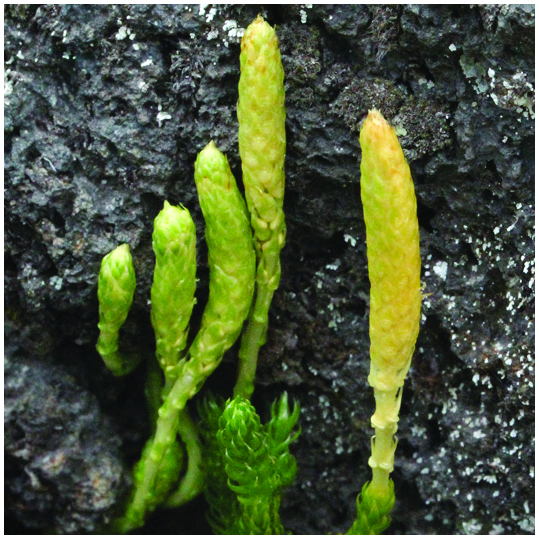
Annals of Botany 123: 145–152, 2019
doi: 10.1093/aob/mcy151
Although plant reproductive structures are incredibly diverse overall, unrelated groups can show strong convergence in specific forms. Bonacorsi and Leslie use lycopsids, an ancient lineage with relatively simple reproductive biology, to test if such convergence results from performing a limited suite of functions, which leads to a reduced set of morphological solutions. Multivariate analyses of living and fossil lycopsids (clubmosses and firmosses) reveals that the group has evolved and maintained very similar reproductive structures over their long evolutionary history, despite major changes in size, growth habit, and ecology. Similar kinds of reproductive structures are also found across plant groups with wind-dispersed pollen or spores.
Authors: Nikole K. Bonacorsi and Andrew B. Leslie
Solving a major controversy in conifer evolution
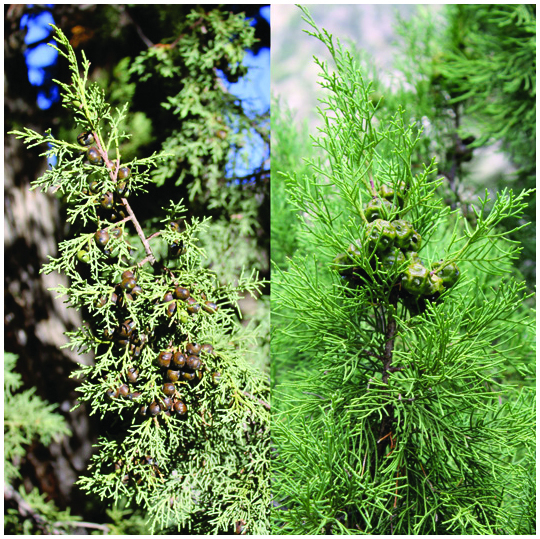
Annals of Botany 123: 153–167, 2019
doi: 10.1093/aob/mcy152
One major and long-standing controversy in conifer evolution concerns the phylogenetic relationships in the subfamily Cupressoideae (Cupressaceae) between Juniperus, Cupressus and the Hesperocyparis-Callitropsis-Xanthocyparis (HCX) clade. Mao et al. reconstruct their phylogenetic relationships using transcriptome data. All tree-building methods lend strong support for the relationship (HCX, (Juniperus, Cupressus)), despite strongly supported conflicts among individual gene trees. Rapid evolutionary divergence and incomplete lineage sorting likely acted together as the source for conflicting phylogenetic inferences between gene trees and between our robust results and recently published studies. Subsequent analyses yield a clearer picture of biogeographic history yet small changes to previous molecular dating efforts.
Authors: Kangshan Mao, Markus Ruhsam, Yazhen Ma, Sean W. Graham, Jianquan Liu, Philip Thomas, Richard I. Milne, and Peter M. Hollingsworth
Submergence tolerance traits in the forage legume Melilotus siculus
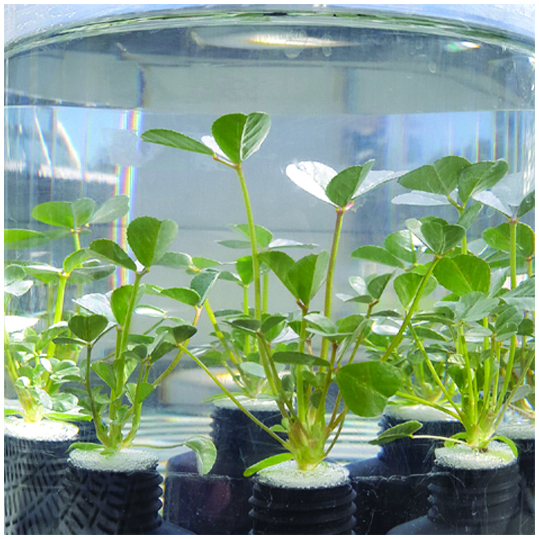
Annals of Botany 123: 169–180, 2019
doi: 10.1093/aob/mcy153
Submergence is a severe stress for most plants. Striker et al. assess tolerances of partial and full submergence for fifteen accessions of Melilotus siculus (Fabaceae). Traits differing among accessions and associated with tolerance were leaflet gas film thickness upon submergence, gas-filled spaces in petioles and aerenchymatous phellem near the base of the main root. All accessions re-orientated petioles towards the vertical in both submergence treatments. Petiole extension rates were maintained during partial submergence, but decreased during full submergence. Leaflet sugars accumulated during partial submergence, but were depleted during full submergence. The ability to retain green leaves was essential for recovery following de-submergence.
Authors: Gustavo G. Striker, Lukasz Kotula, and Timothy D. Colmer
Correlated evolution-flower size and seed number
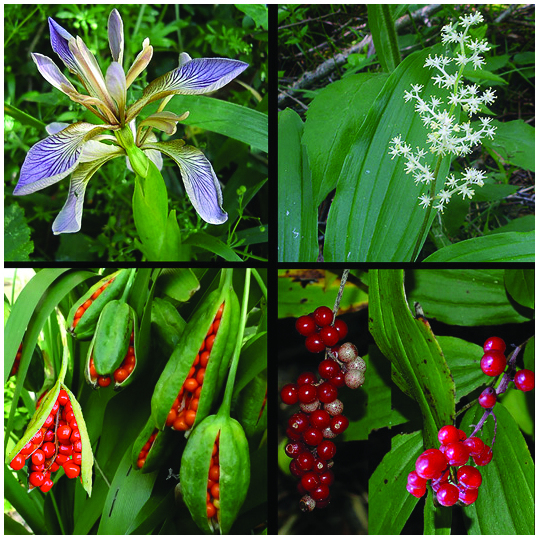
Annals of Botany 123: 181–190, 2019
doi: 10.1093/aob/mcy154
Evolution of large flowers and associated specialized pollination mechanisms may increase the genetic relatedness of seeds within multi-ovulate ovaries by pollination of all ovules by one pollen parent, minimizing effects of competition among developing seeds through kin selection. Using phylogenetically independent trait data, Bawa et al. show strong correlated evolution between flower size and seed number. Angiosperms seem to fall into two categories: large flowers with specialized pollinators and many seeded fruits, illustrated by the stinking iris, Iris foetidissima (Iridaceae), and small flowers pollinated by generalist insects or wind and single or few seeded fruits, illustrated by the false Solomon’s seal, Maianthemum racemosum (Asparagaceae).
Authors: Kamaljit Bawa, Tenzing Ingty, Liam Revell, and K. N. Shivaprakash
Breeding system evolution in Ficus and Moraceae
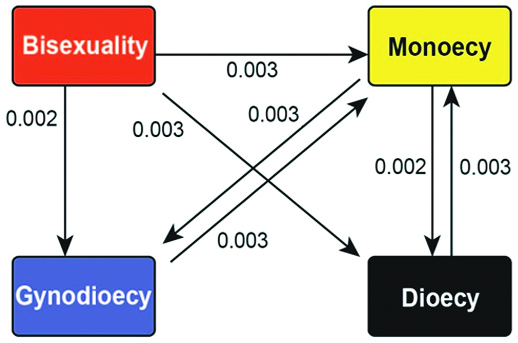
Annals of Botany 123: 191–204, 2019
doi: 10.1093/aob/mcy159
Diverse breeding systems have evolved in angiosperms from the bisexual flowers of their last common ancestor. However, breeding system evolution remains poorly understood in many plant families, including the Moraceae (figs and mulberries). In this paper, Zhang et al. address these questions using a state-of-the-art new dated phylogeny for Moraceae and, for the first time, model-based methods for ancestral state reconstruction. They find very strong support for ancestral dioecy in Moraceae, and show that monoecy was probably an intermediate step towards gynodioecy in Ficus. These results have significant implications for understanding the evolutionary origin of figs as well as breeding systems in general.
Authors: Qian Zhang, Renske E. Onstein, Stefan A. Little, and Hervé Sauquet
Do I need a sexual partner, or is it better to be my own date? The evolution of sexually dimorphic plants
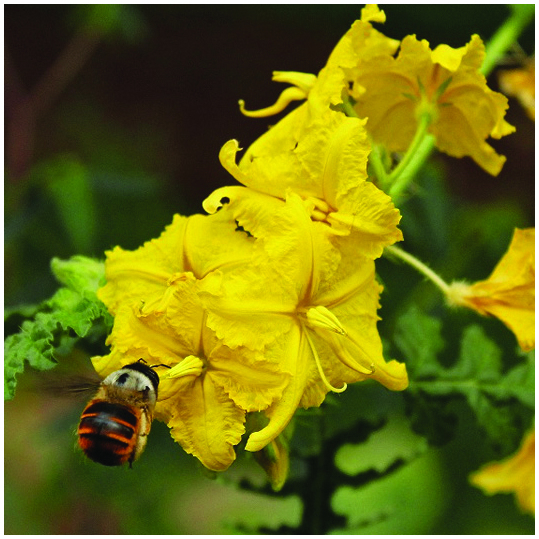
Annals of Botany 123: 205–212, 2019
doi: 10.1093/aob/mcy162
Enantiostyly, a reproductive system characterized by heteromorphic flowers with either left or right style deflection, compels reciprocal pollen transfer between floral types. The potential outcrossing advantage of enantiostyly, however, is blurred when both floral types are produced in the same individual. Accordingly, Mora-Carrera et al. experimentally explored the conditions favouring the stability of monomorphic enantiostyly (ME) versus invasion by a dimorphic form (DE). Under pollen limitation and lack of consorts’ conditions, ME had higher fitness and equivalent outcrossing rates than DE. Thus, in Solanum rostratum (Solanaceae) ME functions as a reproductive assurance mechanism precludes invasion by a dimorphic form.
Authors: Emiliano Mora-Carrera, Miguel Castañeda-Zárate, Juan Fornoni, Karina Boege, and César A. Domínguez
Floral micromorphology of bird-pollinated carnivorous Utricularia
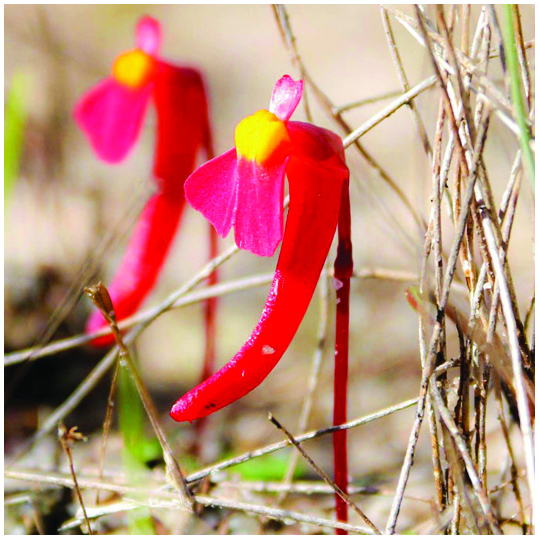
Annals of Botany 123: 213–220, 2019
doi: 10.1093/aob/mcy163
Most bladderworts (genera Pinguicula, Genlisea, Utricularia, Lentibulariaceae) are pollinated by insects. Bird pollination is rare and has probably evolved independently three times in this family. In Western Australia, the Western spinebill, Acanthorhynchus superciliosus, visits flowers of Utricularia menziesii. Płachno et al. study the micromorphology of U. menziesii flowers to assess traits that are likely linked to its pollination strategy. The flowers fulfil many criteria that characterise bird-pollination: red colour, a large, tough nectary spur that can withstand contact with a hard beak, lack of visual nectar guides and fragrance. The hexose-dominant nectar that was detected in flowers of U. menziesii is common in plants pollinated by passerine perching birds.
Authors: Bartosz J. Płachno, Małgorzata Stpiczyńska, Piotr Świątek, Hans Lambers, Vitor F. O. Miranda, Francis J. Nge, Piotr Stolarczyk, and Gregory R. Cawthray



